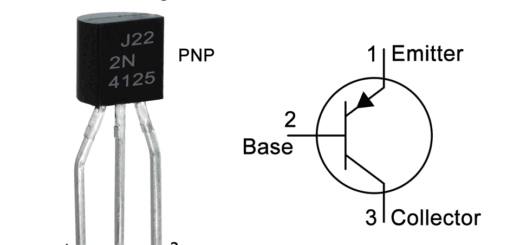TIP140 Transistor Pinout, Equivalent, Features, Applications and Other Details
TIP140 is an NPN darlington transistor of a TIP14x series which also contains other transistors and the complimentary types of these transistors are also available. This post contains information about TIP140 transistor pinout, equivalent, features, applications and other details.
Absolute Maximum Ratings:
- Package Type: TO-218 Or SOT-93
- Transistor Type: NPN Darlington
- Max Collector Current(IC): 10A
- Max Collector-Emitter Voltage (VCE): 60V
- Max Collector-Base Voltage (VCB): 60V
- Max Emitter-Base Voltage (VEBO): 5V
- Max Collector Dissipation (Pc): 125 Watt
- Minimum & Maximum DC Current Gain (hFE): 500 To 1000
- Max Storage & Operating temperature: -65 to +150 Centigrade
PNP Complementary:
PNP complimentary of TIP140 is TIP145
Replacement and Equivalent:
TIP142, TIP141, 2SD1197, NTE270, BDV65B, BDV65C
TIP140 Transistor Explained / Description:
TIP140 is a quite interesting NPN darlington transistor of TIP14X series which also contains other darlington transistors which are TIP141 and TIP142. The complimentary series of these transistors are also available which are TIP145 (Complimentary of TIP140), TIP146(Complimentary of TIP141) and TIP147(Complimentary of TIP142). These transistors are available in TO-218 package but some manufacturers also making it in other packages such as TO-3P and TO-3PN.
Coming back to TIP140 the absolute maximum ratings of the transistor are as follows: the collector current is 10A, collector-emitter voltage is 60V, collector-base voltage is 60V, emitter-base voltage is 5V, collector dissipation is 125W and storage and operating junction temperature is 65°C to 150°C.
TIP140 is designed to be used in general purpose switching and amplifier applications which makes it ideal to be used in wide variety of applications such as power supplies, chargers, amplifier, controller circuits, driver circuits etc. the detailed list of its applications can be found below.
How to Use this Transistor:
Here we discuss the basic procedure to use the transistor as a switch or amplifier so you can understand easily how to use the transistor. A good switch circuit is easy to build but a good audio amplifier circuit requires some additional passive components, to know where you can use these additional passive components to enhance the audio amplifier you require some advanced electronics skills that can be learned by studying and making the amplifier circuits practically. But making simple circuits are not very complicated and you can build them with minimum knowledge.
So to use the transistor as a switch connect its emitter with the negative rail of the circuit apply signals on its base pin (the signals from which you want to control the load) and connect the load between the collector and positive rail of the circuit. Some important points should be remembered that you should not fed the signals to the base pin directly, you should use a current limiting resistor and if your load is a current sensitive device then you must also use a current limiting resistor between positive rail and your load.
To use the transistor as a simple amplifier provide signals that you want to amplify to its base through a suitable electrolytic capacitor, connect the emitter pin with the ground or negative rail of the circuit and connect the collector pin with the output device through a suitable electrolytic capacitor. The output device can be a speaker, so one wire of the speaker will be connected with the collector through the capacitor and the other wire will be connected with the positive rail of the circuit.
Applications:
Audio amplifiers
Motor Drivers
Power Supplies
Battery Chargers
Controller Circuits
Drive load of up to 10A
Lighting Control Circuits
And many other general purpose applications
Safe Operating Guidelines:
Here are the safe operating guidelines of the transistor.
- Use the transistor at least 20% below from its absolute maximum ratings.
- The maximum continuous collector current is 10A but according to the above guidelines we will not drive load of more than 8A.
- Same as the maximum collector-emitter voltage is 60V but we will not drive load of more than 48V.
- A suitable heatsink should be used with the transistor. And the maximum storage and operating temperature should be between -65°C to 150°C.
Datasheet:
To download the datasheet just copy and paste the below link in your browser.
https://www.mouser.com/datasheet/2/68/tip140-tip142-41803.pdf



